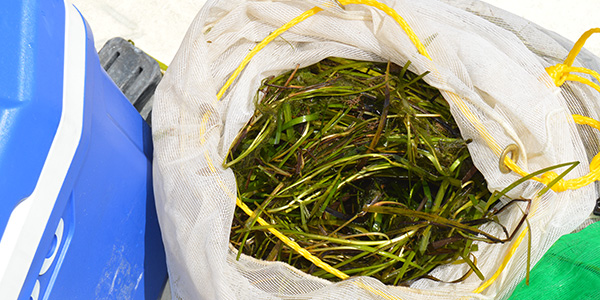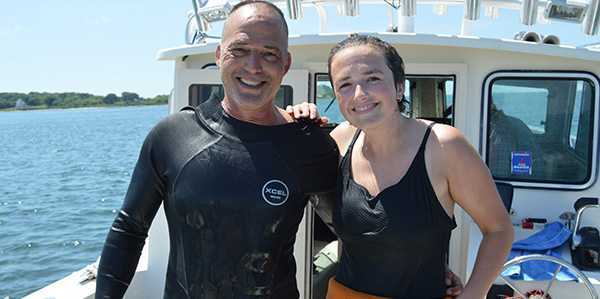This is the first installment in a series of stories that will track the progress of our eelgrass restoration project, a collaboration featuring Save the Sound, SAVE Environmental, and the Cornell Cooperative Extension. The accompanying video is made possible by support from 11th Hour Racing.
Long green stalks rise up from the sea floor like a lush carpet, dancing in the current just a few yards below the surface of the water. Under perfect conditions on an August morning, two divers make their way through the grassy field flourishing off Fishers Island in the easternmost sliver of Long Island Sound, where its waters welcome the Atlantic Ocean within sight of Connecticut, Rhode Island, and Long Island. It is impossible not to be awed by the beauty thriving around them – one diver would later call it a “wonderland of life,” “the most beautiful place” he’s ever been. But this is no pleasure dive. It is entirely of purpose.
After an hour under the waves, Rob Vasiluth of SAVE Environmental and Emma DeLoughry of Save the Sound emerge from their second dive of the day and climb back aboard the Terry Backer II. Before they remove their masks and steel SCUBA tanks, their weight belts and wetsuits – work clothes du jour for this unique assignment – they first hand off their haul: mesh bags packed full with eelgrass, plucked from the abundant meadow below.
It’s not quite a Mission Accomplished moment just yet. But Phase One is done.

“We went down looking for shoots with visible seed pods on them, and tried to pick as many of those as possible while we’re down there on a limited air supply,” said Emma, our Soundkeeper Associate, who also produced this video about the first phase of an ongoing project to restore eelgrass in Long Island Sound.
Time is of the essence – and not just in terms of the length of a dive. Long Island Sound once was home to bountiful beds of eelgrass, a cornerstone species of a healthy aquatic ecosystem. Over the course of several decades, though, eelgrass has all but disappeared in the Sound. It’s a problem all along the east coast, from Chesapeake Bay in the mid-Atlantic to Narragansett Bay in Rhode Island. The shallows off Fishers Island are one of the few areas where eelgrass continues to thrive. And it is from seeds harvested from this rare healthy bed that Rob hopes populations can be restored where they once grew naturally, such as in Smithtown Bay in western Suffolk County.
“The amount of things eelgrass does, it’s like this miracle plant,” said Rob, an operating engineer who worked with cherry pickers, forklifts, and excavators before envisioning the plan that sparked this restoration project.

Since getting involved with Save the Sound and the Cornell Cooperative Extension, Rob has become well-versed in the benefits of eelgrass: its role in carbon sequestration (seagrasses capture carbon at rates faster than terrestrial forests), providing food and habitat for a variety of aquatic life, combatting coastal acidification and coastal erosion, and attenuating wave action by 30%, which provides protection against storm damage.
“I didn’t know any of that when I started out. I just knew it was missing.”
Which is why Rob and Emma wound up spending three dives over two summer days swimming through waving blades of eelgrass, plucking adult stalks like a couple of day hikers picking wildflowers from a blossoming field. Once back on deck, the bags of seed pods were stored in a cooler until Rob could deliver them to be preserved in bubbling salt water tanks in the CCE lab in Southold, NY.
Over the last month, more than 80,000 seeds have fallen from the stalks. That’s plenty for Phase Two, which will involve gluing those seeds to clamshells. Literally. Rob expects he and Emma will affix five seeds to each of nearly 20,000 hatchery clams between 18-30 millimeters in size (which each have a 25-35% chance of surviving when they are deployed across a two-acre area of Smithtown Bay in Phase Three). If the seeds have a 20% viability rate, there could be one new eelgrass plant born on the back of every clam. That would mean up to 20,000 plants taking root in the sea floor where the clams bury themselves.
Then, two years later, when the surviving plants reach maturity, they will have 150-200 of their own stalks. Plus the ability to grow their own seeds. It could mark the birth of a new meadow in Smithtown Bay, all from the seed pods gathered by two divers in one small section of the Sound 85 miles away on a combined six tanks’ worth of compressed air.
You can see why the people involved see such promise in this project.
“It’s really amazing to be part of a project that can be such a game-changer, and not just in the Sound,” said Emma, who completed her SCUBA certification just days before participating in the first dive of the summer. “If we’re successful, it could be replicated anyplace else in the world where they have declining eelgrass population.”
